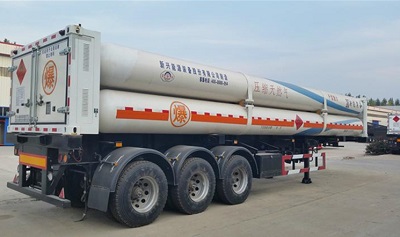Cng container storage/tanker trailer the structure of the oil tank is an elliptical cylindrical or trapezoidal cylindrical body, made of high-quality steel plate. The whole tank body can be divided into a single warehouse or multiple warehouses. The warehouse can be divided into compartments. There is a through-hole at the lower end of the middle partition. Each warehouse is welded with divided warehouses or multiple warehouses. There is a through-hole at the lower end of the intermediate partition, and a sub-bin reinforced wave partition is welded in the middle of each warehouse to reduce the impact of the oil in the tank and increase the rigidity of the tank when the car is sucked.
In order to ensure that the CNG container storage/tanker trailer is working, the pressure in the tank is basically the same as the atmospheric pressure, a breathing valve is installed on the large cover of the tank. When the oil in the tank expands due to heat or when the oil pump is used to refuel the tank, the oil level in the tank rises, and the pressure increases. When the pressure in the tank is greater than the external pressure of 8KPA, the valve plate of the breathing valve opens. When the oil pump is used to discharge oil or the oil is cold and contracted, the oil level drops, and the pressure drops. When the pressure in the tank is lower than the external pressure 3KPA, the lower valve plate of the breathing valve opens.

Advantages of Cng container storage/tanker trailer
1. High safety performance: the bottle body has good plastic toughness, uniform acceptance, and reasonable stress distribution;
2. Good fatigue resistance: using a finite element for fatigue analysis design to ensure the fatigue resistance of the equipment;
3. There are safety relief devices at both ends of the bottle body. In case of abnormal working conditions such as overpressure or fire, the safety relief device will work automatically to ensure the safety of property and personnel.
Transportation requirements of Cng container storage/tanker trailer
The tank loading and unloading port of the Cng container storage/tanker trailer should be equipped with metal material valve boxes or anti-collision barriers and other protective devices and should be equipped with sealing covers or sealed leak collectors. The loading and unloading valves, instruments, and other auxiliary devices at the rear of compressed gas long-tube trailers, cryogenic liquid transport vehicles, and semi-trailers should be centrally arranged in the metal valve box. The installation position of the loading and unloading valve should meet the following requirements according to different transportation media:
1. If the loading and unloading valve of the Cng container storage/tanker trailer is installed at the rear of the tank, the ground clearance of its loading and unloading valves, pipes, and other accessories shall not be lower than the ground clearance of the rear protective device.
2. The loading and unloading valve of the Cng container storage/tanker trailer should be installed between the front axle and the rear bumper. The longitudinal distance between the rear head of the tank and the pipeline and pipeline accessories and the rear lower protective device should be greater than or equal to 150mm. The loading and unloading valve of the light fuel oil transport semi-trailer should be installed between the outrigger and the rear axle.
3. The loading and unloading valve of Cng container storage/tanker trailer should be installed at the position between the rear axle and the rear guard of the vehicle, and the longitudinal distance between the rear head of the tank and the pipeline and pipeline accessories and the rear lower guard should be greater than Equal to 150mm. The loading and unloading valve of the chemical liquid transport vehicle that transports highly toxic liquids and strongly corrosive liquids should be installed on the top of the tank. The high point of the pipe joints, valves, and other accessories on the top of the tank should be lower than the overturning protection device, and the high point should be at least 20mm.
4. The loading and unloading valves of extremely hazardous and highly hazardous toxic gas transport vehicles and semi-trailers in the “Classification of Toxicity and Explosion Hazards of Chemical Medium in Pressure Vessels” should be installed on the top of the tank, and the pipe joints, valves and For other accessories, the high point should be lower than the overturn protection device, and the high point should be at least 20mm.
5. The loading and unloading valve of the Cng container storage/tanker trailer should be installed on the side of the vehicle, between the front axle and the rear axle of the vehicle. The loading and unloading valves of compressed gas transport semi-trailers and liquefied gas transport semi-trailers should be installed on the side of the vehicle, between the outriggers and the rear axle.

 English
English


